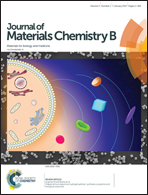Development of demineralized bone matrix-based implantable and biomimetic microcarrier for stem cell expansion and single-step tissue-engineered bone graft construction†
Abstract
Tissue engineered bone grafts (TEBG) using mesenchymal stem cells (MSCs) demonstrate great potential for bone defect treatment. However, current MSC expansion techniques and multiple-step TEBG construction strategy have problems such as repeated trypsinization, limiting further clinical application. Microcarriers present promising solutions, but conventional microcarriers are either non-implantable or have insufficient biomimetic potential to maintain effective cellular function. Here, we developed a biomimetic and implantable microcarrier using demineralized bone matrix (DBM-MC), which preserves the essential biochemical composition, architecture and surface topography of natural bone tissue. Furthermore, based on this DBM-MC, we established a single-step micro-sized TEBG (μTEBG) construction strategy integrating multiple procedures of cell seeding, expansion, and differentiation. Benchmarked with Cytodex 3, a widely used microcarrier, DBM-MC shared similar physical properties, and supported efficient cell adhesion and proliferation with MSC characteristics being well maintained. However, when implanted ectopically, the MSC/DBM-MC constructs achieved more neo-bone formation with better vascularization than MSC/Cytodex 3. Moreover, μTEBG generated via our single-step strategy can successfully heal a critical-sized cranial defect with two-fold more bone regeneration. This new DBM-MC and single-step μTEBG construction strategy can provide an enclosed, large-scale, reduced-trypsinization, and semi-automatic fabrication process to generate μTEBGs with outstanding osteogenic and angiogenic capacity, demonstrating great potential for clinical application.


 Please wait while we load your content...
Please wait while we load your content...